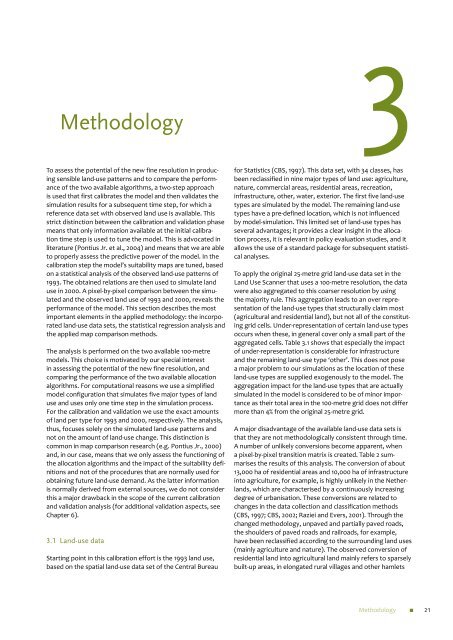PBL rapport 550026002 Calibration and validation of the land use ...
PBL rapport 550026002 Calibration and validation of the land use ...
PBL rapport 550026002 Calibration and validation of the land use ...
You also want an ePaper? Increase the reach of your titles
YUMPU automatically turns print PDFs into web optimized ePapers that Google loves.
Methodology 3<br />
To assess <strong>the</strong> potential <strong>of</strong> <strong>the</strong> new fine resolution in producing<br />
sensible l<strong>and</strong>-<strong>use</strong> patterns <strong>and</strong> to compare <strong>the</strong> performance<br />
<strong>of</strong> <strong>the</strong> two available algorithms, a two-step approach<br />
is <strong>use</strong>d that first calibrates <strong>the</strong> model <strong>and</strong> <strong>the</strong>n validates <strong>the</strong><br />
simulation results for a subsequent time step, for which a<br />
reference data set with observed l<strong>and</strong> <strong>use</strong> is available. This<br />
strict distinction between <strong>the</strong> calibration <strong>and</strong> <strong>validation</strong> phase<br />
means that only information available at <strong>the</strong> initial calibration<br />
time step is <strong>use</strong>d to tune <strong>the</strong> model. This is advocated in<br />
literature (Pontius Jr. et al., 2004) <strong>and</strong> means that we are able<br />
to properly assess <strong>the</strong> predictive power <strong>of</strong> <strong>the</strong> model. In <strong>the</strong><br />
calibration step <strong>the</strong> model’s suitability maps are tuned, based<br />
on a statistical analysis <strong>of</strong> <strong>the</strong> observed l<strong>and</strong>-<strong>use</strong> patterns <strong>of</strong><br />
1993. The obtained relations are <strong>the</strong>n <strong>use</strong>d to simulate l<strong>and</strong><br />
<strong>use</strong> in 2000. A pixel-by-pixel comparison between <strong>the</strong> simulated<br />
<strong>and</strong> <strong>the</strong> observed l<strong>and</strong> <strong>use</strong> <strong>of</strong> 1993 <strong>and</strong> 2000, reveals <strong>the</strong><br />
performance <strong>of</strong> <strong>the</strong> model. This section describes <strong>the</strong> most<br />
important elements in <strong>the</strong> applied methodology: <strong>the</strong> incorporated<br />
l<strong>and</strong>-<strong>use</strong> data sets, <strong>the</strong> statistical regression analysis <strong>and</strong><br />
<strong>the</strong> applied map comparison methods.<br />
The analysis is performed on <strong>the</strong> two available 100-metre<br />
models. This choice is motivated by our special interest<br />
in assessing <strong>the</strong> potential <strong>of</strong> <strong>the</strong> new fine resolution, <strong>and</strong><br />
comparing <strong>the</strong> performance <strong>of</strong> <strong>the</strong> two available allocation<br />
algorithms. For computational reasons we <strong>use</strong> a simplified<br />
model configuration that simulates five major types <strong>of</strong> l<strong>and</strong><br />
<strong>use</strong> <strong>and</strong> <strong>use</strong>s only one time step in <strong>the</strong> simulation process.<br />
For <strong>the</strong> calibration <strong>and</strong> <strong>validation</strong> we <strong>use</strong> <strong>the</strong> exact amounts<br />
<strong>of</strong> l<strong>and</strong> per type for 1993 <strong>and</strong> 2000, respectively. The analysis,<br />
thus, foc<strong>use</strong>s solely on <strong>the</strong> simulated l<strong>and</strong>-<strong>use</strong> patterns <strong>and</strong><br />
not on <strong>the</strong> amount <strong>of</strong> l<strong>and</strong>-<strong>use</strong> change. This distinction is<br />
common in map comparison research (e.g. Pontius Jr., 2000)<br />
<strong>and</strong>, in our case, means that we only assess <strong>the</strong> functioning <strong>of</strong><br />
<strong>the</strong> allocation algorithms <strong>and</strong> <strong>the</strong> impact <strong>of</strong> <strong>the</strong> suitability definitions<br />
<strong>and</strong> not <strong>of</strong> <strong>the</strong> procedures that are normally <strong>use</strong>d for<br />
obtaining future l<strong>and</strong>-<strong>use</strong> dem<strong>and</strong>. As <strong>the</strong> latter information<br />
is normally derived from external sources, we do not consider<br />
this a major drawback in <strong>the</strong> scope <strong>of</strong> <strong>the</strong> current calibration<br />
<strong>and</strong> <strong>validation</strong> analysis (for additional <strong>validation</strong> aspects, see<br />
Chapter 6).<br />
3.1<br />
L<strong>and</strong>-<strong>use</strong> data<br />
Starting point in this calibration effort is <strong>the</strong> 1993 l<strong>and</strong> <strong>use</strong>,<br />
based on <strong>the</strong> spatial l<strong>and</strong>-<strong>use</strong> data set <strong>of</strong> <strong>the</strong> Central Bureau<br />
for Statistics (CBS, 1997). This data set, with 34 classes, has<br />
been reclassified in nine major types <strong>of</strong> l<strong>and</strong> <strong>use</strong>: agriculture,<br />
nature, commercial areas, residential areas, recreation,<br />
infrastructure, o<strong>the</strong>r, water, exterior. The first five l<strong>and</strong>-<strong>use</strong><br />
types are simulated by <strong>the</strong> model. The remaining l<strong>and</strong>-<strong>use</strong><br />
types have a pre-defined location, which is not influenced<br />
by model-simulation. This limited set <strong>of</strong> l<strong>and</strong>-<strong>use</strong> types has<br />
several advantages; it provides a clear insight in <strong>the</strong> allocation<br />
process, it is relevant in policy evaluation studies, <strong>and</strong> it<br />
allows <strong>the</strong> <strong>use</strong> <strong>of</strong> a st<strong>and</strong>ard package for subsequent statistical<br />
analyses.<br />
To apply <strong>the</strong> original 25-metre grid l<strong>and</strong>-<strong>use</strong> data set in <strong>the</strong><br />
L<strong>and</strong> Use Scanner that <strong>use</strong>s a 100-metre resolution, <strong>the</strong> data<br />
were also aggregated to this coarser resolution by using<br />
<strong>the</strong> majority rule. This aggregation leads to an over representation<br />
<strong>of</strong> <strong>the</strong> l<strong>and</strong>-<strong>use</strong> types that structurally claim most<br />
(agricultural <strong>and</strong> residential l<strong>and</strong>), but not all <strong>of</strong> <strong>the</strong> constituting<br />
grid cells. Under-representation <strong>of</strong> certain l<strong>and</strong>-<strong>use</strong> types<br />
occurs when <strong>the</strong>se, in general cover only a small part <strong>of</strong> <strong>the</strong><br />
aggregated cells. Table 3.1 shows that especially <strong>the</strong> impact<br />
<strong>of</strong> under-representation is considerable for infrastructure<br />
<strong>and</strong> <strong>the</strong> remaining l<strong>and</strong>-<strong>use</strong> type ‘o<strong>the</strong>r’. This does not pose<br />
a major problem to our simulations as <strong>the</strong> location <strong>of</strong> <strong>the</strong>se<br />
l<strong>and</strong>-<strong>use</strong> types are supplied exogenously to <strong>the</strong> model. The<br />
aggregation impact for <strong>the</strong> l<strong>and</strong>-<strong>use</strong> types that are actually<br />
simulated in <strong>the</strong> model is considered to be <strong>of</strong> minor importance<br />
as <strong>the</strong>ir total area in <strong>the</strong> 100-metre grid does not differ<br />
more than 4% from <strong>the</strong> original 25-metre grid.<br />
A major disadvantage <strong>of</strong> <strong>the</strong> available l<strong>and</strong>-<strong>use</strong> data sets is<br />
that <strong>the</strong>y are not methodologically consistent through time.<br />
A number <strong>of</strong> unlikely conversions become apparent, when<br />
a pixel-by-pixel transition matrix is created. Table 2 summarises<br />
<strong>the</strong> results <strong>of</strong> this analysis. The conversion <strong>of</strong> about<br />
13,000 ha <strong>of</strong> residential areas <strong>and</strong> 10,000 ha <strong>of</strong> infrastructure<br />
into agriculture, for example, is highly unlikely in <strong>the</strong> Ne<strong>the</strong>rl<strong>and</strong>s,<br />
which are characterised by a continuously increasing<br />
degree <strong>of</strong> urbanisation. These conversions are related to<br />
changes in <strong>the</strong> data collection <strong>and</strong> classification methods<br />
(CBS, 1997; CBS, 2002; Raziei <strong>and</strong> Evers, 2001). Through <strong>the</strong><br />
changed methodology, unpaved <strong>and</strong> partially paved roads,<br />
<strong>the</strong> shoulders <strong>of</strong> paved roads <strong>and</strong> railroads, for example,<br />
have been reclassified according to <strong>the</strong> surrounding l<strong>and</strong> <strong>use</strong>s<br />
(mainly agriculture <strong>and</strong> nature). The observed conversion <strong>of</strong><br />
residential l<strong>and</strong> into agricultural l<strong>and</strong> mainly refers to sparsely<br />
built-up areas, in elongated rural villages <strong>and</strong> o<strong>the</strong>r hamlets<br />
Methodology 21
















